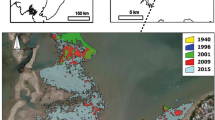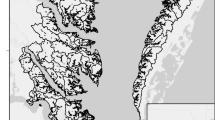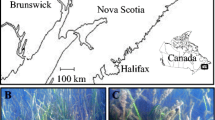Abstract
According to Zertuche-González et al. (2009), Ulva spp. blooms, favored by oyster cultivation, are likely displacing subtidal meadows of Zostera marina in San Quintin Bay, Baja California. The authors propose a partial removal of the seaweed to reduce the risk of eutrophication and eelgrass displacement in the bay. We warn about the removal of Ulva spp. biomass by raising six arguments that emphasize the necessity of a historical and ecosystem-based management for San Quintin Bay. First, processes other than competitive exclusion by Ulva spp. blooms more likely explain changes of Z. marina subtidal meadows in the past decade. Second, there is no consistent evidence that oyster cultivation is promoting blooms of Ulva spp. and the loss of eelgrass. Third, the removal of Ulva spp. biomass is based on experiences of heavily anthropogenically eutrophic systems, while San Quintin Bay is not. Fourth, the proposed course of actions to restore eelgrass meadows ignores general historical baselines of estuarine and coastal systems by confusing what it means to be “pristine.” Fifth, despite the important experimental evidence indicating strong top–down control in temperate seagrass meadows, Zertuche-González et al. (2009) underestimated the capacity of consumers in structuring dynamics of vegetated soft-bottom communities in San Quintin Bay. Sixth, Ulva expansa may exert positive effects on seagrass ecosystem properties and functions. Instead, we propose protection against the propagation of unsustainable practices in the bay, and the reintroduction of large consumers that are now absent in this ecosystem. An ecosystem-based analysis of the role of Ulva spp. on eelgrass dynamics is needed.


Similar content being viewed by others
References
Aguilar-Rosas R, López-Carrillo M, Aguilar-Rosas LE (2005) Macroalgas marinas de la Bahía de San Quintín, Baja California, México. Polibotánica 19:19–38
Aguirre-Muñoz A, Buddemeier RW, Camacho-Ibar VF, Carriquiry JD, Ibarra-Obando SE, Massey BW, Smith SV, Wulff F (2001) Sustainability of coastal resource use in San Quintin, Mexico. Ambio 30(3):142–149
Alvarez-Borrego S (2004) Nutrient and phytoplankton dynamics in a coastal lagoon strongly affected by coastal upwelling. Cienc Mar 30(1A):1–19
Arroyo N, Aarnio K, Bonsdorff E (2006) Drifting algae as a means of re-colonizing defaunated sediments in the Baltic Sea. A short-term microcosm study. Hydrobiologia 554(1):83–95
Bakun A, Nelson CS (1977) Climatology of upwelling related processes off Baja California. CalCOFI Reports 19:107–127
Barnard JL (1962) Benthic marine exploration of Bahía de San Quintín, Baja California, 1960–61, General. Pac Nat 3(6):251–274
Barnard JL (1964) Marine amphipoda of Bahía de San Quintín, Baja California. Pac Nat 4(3):58–77
Barnard JL (1970) Benthic Ecology of Bahia San Quintin, Baja California. Smithsonian Institution Press, Washington, p 30
Boyer KE, Fong P (2005) Macroalgal-mediated transfers of water column nitrogen to intertidal sediments and salt marsh plants. J Exp Mar Biol Ecol 321(1):59–69
Burkepile DE, Hay ME (2006) Herbivore vs. nutrient control of marine primary producers: context-dependent effects. Ecology 87(12):3128–3139
Caso M, Gonzalez-Abraham C, Ezcurra E (2007) Divergent ecological effects of oceanographic anomalies on terrestrial ecosystems of the Mexican Pacific coast. Proc Natl Acad Sci USA 104(25):10530–10535
Catenazzi A, Donnelly MA (2007) The Ulva connection: marine algae subsidize terrestrial predators in coastal Peru. Oikos 116(1):75–86
Cellina F, De Leo GA, Rizzoli AE, Viaroli P, Bartoli M (2003) Economic modelling as a tool to support macroalgal bloom management: a case study (Sacca di Goro, Po river delta). Oceanol Acta 26:139–147
Coffaro G, Bocci M (1997) Resouurces competition between Ulva rigida and Zostera marina: a quantitative approach applied to the Lagoon of Venice. Ecol Model 102(1):81–95
Cummins SP, Roberts DE, Zimmerman KD (2004) Effects of the green macroalga Enteromorpha intestinalis on macrobenthic and seagrass assemblages in a shallow coastal estuary. Mar Ecol Prog Ser 266:77–87
Dawson EY (1962) Benthic marine exploration of Bahia de San Quintin, Baja California, 1960–61. Marine and marsh vegetation. Pac Nat 3(7):275–280
Eckrich CE, Holmquist JG (2000) Trampling in a seagrass assemblage: direct effects, response of associated fauna, and the role of substrate characteristics. Mar Ecol Prog Ser 201:199–209
Eriksson BK, Rubach A, Hillebrand H (2007) Dominance by a canopy forming seaweed modifies resource and consumer control of bloom-forming macroalgae. Oikos 116(7):1211–1219
Fong P, Boyer KE, Desmond JS, Zedler JB (1996) Salinity stress, nitrogen competition, and facilitation: what controls seasonal succession of two opportunistic green macroalgae? J Exp Mar Biol Ecol 206(1–2):203–221
Goericke R, Venrick E, Mantyla A, Bograd SJ, Schwing FB, Huyer A, Smith RL, Wheeler PA, Hooff R, Peterson WT (2005) The state of the California Current, 2004–2005: still cool? CalCOFI Report 46:32–71
Hall SR, Shurin JB, Diehl S, Nisbet RM (2007) Food quality, nutrient limitation of secondary production, and the strength of trophic cascades. Oikos 116(7):1128–1143
Hammerstrom KK, Kenworthy WJ, Whitfield PE, Merello MF (2007) Response and recovery dynamics of seagrasses Thalassia testudinum and Syringodium filiforme and macroalgae in experimental motor vessel disturbances. Mar Ecol Prog Ser 345:83–92
Hauxwell J, Cebrián J, Furlong C, Valiela I (2001) Macroalgal canopies contribute to eelgrass (Zostera marina) decline in temperate estuarine ecosystems. Ecology 82(4):1007–1022
Hernández-Ayón JM, Galindo-Bect S, Camacho-Ibar V, García-Esquivel Z, González-Gómez MA, Ley-Lou F (2004) Nutrient dynamics in the west arm of San Quintín Bay, Baja California, Mexico, during and after El Niño 1997/1998. Cienc Mar 30(1A):119–132
Hughes AR, Bando KJ, Rodriguez LF, Williams SL (2004) Relative effects of grazers and nutrients on seagrasses: a meta-analysis approach. Mar Ecol Prog Ser 282:87–99
Huntington BE, Boyer KE (2008) Effects of red macroalgal (Gracilariopsis sp.) abundance on eelgrass Zostera marina in Tomales Bay, California, USA. Mar Ecol Prog Ser 367:133–142
Ibarra-Obando SE, Aguilar-Rosas R (1985) Drift and epiphytic macroalgae associated with Zostera marina L. in San Quintin Bay (B.C., Mexico) during summer-autumn 1982: biomass and taxonomic composition. Cienc Mar 11(3):89–104
Ibarra-Obando SE, Solana-Arellano E, Poumian-Tapia M (2007) El Papel de Zostera marina en el Ciclo del Carbono en Bahía San Quintín, Baja California. In: Hernández de la Torre B, Gaxiola-Castro G (eds) Carbono en Ecosistemas Acuáticos de México. Instituto Nacional de Ecología, Distrito Federal, México, pp 201–213
Irlandi EA, Orlando BA, Biber PD (2004) Drift algae-epiphyte-seagrass interactions in a subtropical Thalassia testudinum meadow. Mar Ecol Prog Ser 279:81–91
Jackson JBC (2001) What was natural in the coastal oceans? Proc Natl Acad Sci USA 98(10):5411–5418
Jackson JBC, Kirby MX, Berger WH, Bjorndal KA, Botsford LW, Bourque BJ, Bradbury RH, Cook R, Erlandson J, Estes JA, Hughes TP, Kidwell S, Lange K, Lenihan HS, Pandolfi JF, Peterson CH, Steneck RS, Tegner MJ, Warner RR (2001) Historical overfishing and the recent collapse of coastal ecosystems. Science 293(5530):629–638
Jorgensen P (2006) Control de Zostera marina por consumidores y recursos en praderas bajo diferentes regímenes de fertilización natural. PhD thesis in Marine Ecology, Centro de Investigación Científica y de Educación Superior de Ensenada, Baja California, México
Jorgensen P, Ibarra-Obando SE, Carriquiry JD (2007) Top-down and bottom-up stabilizing mechanisms in eelgrass meadows differentially affected by coastal upwelling. Mar Ecol Prog Ser 333:81–93
Jormalainen V, Honkanen T (2008) Macroalgal chemical defenses and their roles in structuring temperate marine communities. In: Amsler CD (ed) Algal chemical ecology. Springer, Berlin, pp 57–89
Kraufvelin P, Moy FE, Christie H, Bokn TL (2006) Nutrient addition to experimental rocky shore communities revisited: delayed responses, rapid recovery. Ecosystems 9(7):1076–1093
López-Mendilaharsu M, Gardner SC, Seminoff JA, Riosmena-Rodriguez R (2005) Identifying critical foraging habitats of the green turtle (Chelonia mydas) along the Pacific coast of the Baja California peninsula, Mexico. Aquat Conserv 15(3):259–269
Lotze HK, Worm B, Sommer U (2001) Strong bottom-up and top-down control of early life stages of macroalgae. Limnol Oceanogr 46(4):749–757
Lotze HK, Lenihan HS, Bourque BJ, Bradbury RH, Cooke RG, Kay MC, Kidwell SM, Kirby MX, Peterson CH, Jackson JBC (2006) Depletion, degradation, and recovery potential of estuaries and coastal seas. Science 312(5781):1806–1809
Moksnes P-O, Gullstrom M, Tryman K, Baden S (2008) Trophic cascades in a temperate seagrass community. Oikos 117(5):763–777
Nelson TA, Lee A (2001) A manipulative experiment demonstrates that blooms of the macroalga Ulvaria obscura can reduce eelgrass shoot density. Aquat Bot 71(2):149–154
Nelson TA, Haberlin K, Nelson AV, Ribarich H, Hotchkiss R, Van Alstyne KL, Buckingham L, Simunds DJ, Fredrickson K (2008) Ecological and physiological controls of species composition in green macroalgal blooms. Ecology 89(5):1287–1298
Pandolfi JM, Bradbury RH, Sala E, Hughes TP, Bjorndal KA, Cooke RG, McArdle D, McClenachan L, Newman MJH, Paredes G, Warner RR, Jackson JBC (2003) Global trajectories of the long-term decline of coral reef ecosystems. Science 301(5635):955–958
Paul NA, de Nys R, Steinberg PD (2006) Seaweed-herbivore interactions at a small scale: direct tests of feeding deterrence by filamentous algae. Mar Ecol Prog Ser 323:1–9
Phillips DL, Gregg JW (2003) Source partitioning using stable isotopes: coping with too many sources. Oecologia 136(2):261–269
Phillips DL, Koch PL (2002) Incorporating concentration dependence in stable isotope mixing models. Oecologia 130(1):114–125
Shurin JB, Borer ET, Seabloom EW, Anderson K, Blanchette CA, Broitman B, Cooper SD, Halpern BS (2002) A cross-ecosystem comparison of the strength of trophic cascades. Ecol Lett 5(6):785–791
Taylor RB, Steinberg PD (2005) Host use by australasian seaweed mesograzers in relation to feeding preferences of larger grazers. Ecology 86(11):2955–2967
Valiela I, McClelland J, Hauxwell J, Behr PJ, Hersh D, Foreman K (1997) Macroalgal blooms in shallow estuaries: controls and ecophysiological and ecosystem consequences. Limnol Oceanogr 42:1105–1118
Van Alstyne KL, Wolfe GV, Freidenburg TL, Neill A, Hicken C (2001) Activated defense systems in marine macroalgae: evidence for an ecological role for DMSP cleavage. Mar Ecol Prog Ser 213:53–65
Van Alstyne KL, Nelson A, Vyvyan J, Cancilla D (2006) Dopamine functions as an antiherbivore defense in the temperate green alga Ulvaria obscura. Oecologia 148(2):304–311
Ward DH, Morton A, Tibbitts TL, Douglas DC, Carrera-González E (2003) Long-term change in eelgrass distribution at Bahía San Quintín, Baja California, Mexico, using satellite imagery. Estuaries 26(6):1529–1539
Ward DH, Tibbitts TL, Morton A, Carrera-González E, Kempka R (2004) Use of digital multispectral videography to assess seagrass distribution in San Quintín Bay, Baja California, Mexico. Cienc Mar 30(1A):57–70
Zertuche-González J, Camacho-Ibar V, Pacheco-Ruíz I, Cabello-Pasini A, Galindo-Bect L, Guzmán-Calderón J, Macias-Carranza V, Espinoza-Avalos J (2009) The role of Ulva spp. as a temporary nutrient sink in a coastal lagoon with oyster cultivation and upwelling influence. J Appl Phycol. doi:10.1007/s10811-10009-19408-y
Acknowledgments
Research funding was provided by SIMAC (grant 7013), CONACYT (grant 11 25030-T), and UABC (grant 4041). P.J. was supported by posdoctoral scholarship from CONACYT (Convenio 290523)
Author information
Authors and Affiliations
Corresponding author
Rights and permissions
About this article
Cite this article
Jorgensen, P., Ibarra-Obando, S.E. & Carriquiry, J.D. Management of natural Ulva spp. blooms in San Quintin Bay, Baja California: Is it justified?. J Appl Phycol 22, 549–558 (2010). https://doi.org/10.1007/s10811-009-9491-0
Received:
Revised:
Accepted:
Published:
Issue Date:
DOI: https://doi.org/10.1007/s10811-009-9491-0




